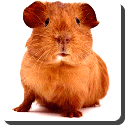 Guinea Pig — The Guinea pig (also commonly called the cavy after its scientific name) is a species of rodent belonging to the family Caviidae and the genus Cavia. Despite their common name, these animals are not pigs, nor do they come from Guinea. They are native to the Andes, and while no longer extant in the wild, they are closely related to several species that are commonly found in the grassy plains and plateaus of the region. The guinea pig plays an important role in the folk culture of many indigenous South American groups, especially as a food source, but also in folk medicine and in community religious ceremonies. Since the 1960s, efforts have been made to increase consumption of the animal outside South America.
Guinea Pig — The Guinea pig (also commonly called the cavy after its scientific name) is a species of rodent belonging to the family Caviidae and the genus Cavia. Despite their common name, these animals are not pigs, nor do they come from Guinea. They are native to the Andes, and while no longer extant in the wild, they are closely related to several species that are commonly found in the grassy plains and plateaus of the region. The guinea pig plays an important role in the folk culture of many indigenous South American groups, especially as a food source, but also in folk medicine and in community religious ceremonies. Since the 1960s, efforts have been made to increase consumption of the animal outside South America.
In Western societies, the guinea pig has enjoyed widespread popularity as a household pet since its introduction by European traders in the 16th century. Their docile nature, their responsiveness to handling and feeding, and the relative ease of caring for them, continue to make the guinea pig a popular pet. Organizations devoted to competitive breeding of guinea pigs have been formed worldwide, and many specialized breeds of guinea pig, with varying coat colors and compositions, are cultivated by breeders.
Guinea pig is also used as a metaphor in English for a subject of experimentation; this usage became common in the first half of the 20th century. Biological experimentation on guinea pigs has been carried out since the 17th century; the animals were frequently used as a model organism in the 19th and 20th centuries, but have since been largely replaced by other rodents such as mice and rats. They are still used in research, primarily as models for human medical conditions such as juvenile diabetes, tuberculosis, scurvy, and pregnancy complications.
Guinea pigs can learn complex paths to food, and can accurately remember a learned path for months. Their strongest and overwhelming problem solving strategy is ‘activity’ While guinea pigs can jump small obstacles, they cannot climb, and are not particularly agile. They startle extremely easily, and will either freeze in place for long periods or run for cover with rapid, darting motions when they sense danger. Larger groups of startled guinea pigs will “stampede”, running in haphazard directions as a means of confusing predators. When excited, guinea pigs may repeatedly perform little hops in the air (known as “popcorning”), a movement analogous to the ferret’s war dance. They are also exceedingly good swimmers.
Unlike many rodents, guinea pigs do not participate in social grooming, though they regularly self-groom. A milky-white substance is secreted from their eyes and rubbed into the hair during the grooming process. Groups of boars will often chew each other’s hair, but this is a method of establishing hierarchy within a group, rather than a social gesture. Dominance is also established through biting (especially of the ears), piloerection, aggressive noises, head thrusts, and leaping attacks. Non-sexual simulated mounting for dominance is also common among same-sex groups.
 Kids Portal For Parents India Kids Network
Kids Portal For Parents India Kids Network






